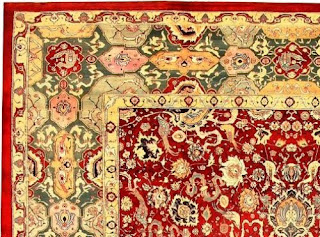Here are a few samples of the Backs of Single Wefted rugs:
Please visit What is a Single Wefted Rug
This rug is woven in the usual Hamadan technique. The wefts are thicker than the wefts and the warps bend from the heavier wefts. With one shot of heavier weft the rug shows much white on the back.
This is a rare one. Maybe less than 1% of all Tekke Rugs are single wefted. Almost all Tekke Rugs have two rows of wefts in between each row of knots but a small and rare group only have one row of weft between each row of knots. The tekke used this technique to make pieces finer and more supple than normal.
The Hamadan Weave is single wefted. There is one heavy weft between each row of knots and the warps lace around the wefts.
This yastik surprised me when I felt it. It is more solid then most really old yastik. Most have a floppy handle and this one is firm. The reason can be seen below. This is a rather rare single weft construction while almost all Turkish rugs have two shots of weft between each row of knots this yastik has but one.
Antique Bergama Area Yastik w/Single Weft Keshishian Collection
Bergama Area Yastik that I suspect is older than you would think.
Waps: Two ply Ivory wool.
Wefts 1 shot of two ivory wool singles.
Knot: Symetrical, 6.5 by 10.5 knots to the inch, 68 kpsi.
Size 35 by 18
Please visit What is a Single Wefted Rug
This rug is woven in the usual Hamadan technique. The wefts are thicker than the wefts and the warps bend from the heavier wefts. With one shot of heavier weft the rug shows much white on the back.
This is a rare one. Maybe less than 1% of all Tekke Rugs are single wefted. Almost all Tekke Rugs have two rows of wefts in between each row of knots but a small and rare group only have one row of weft between each row of knots. The tekke used this technique to make pieces finer and more supple than normal.
The Hamadan Weave is single wefted. There is one heavy weft between each row of knots and the warps lace around the wefts.
This yastik surprised me when I felt it. It is more solid then most really old yastik. Most have a floppy handle and this one is firm. The reason can be seen below. This is a rather rare single weft construction while almost all Turkish rugs have two shots of weft between each row of knots this yastik has but one.
Antique Bergama Area Yastik w/Single Weft Keshishian Collection
Bergama Area Yastik that I suspect is older than you would think.
Waps: Two ply Ivory wool.
Wefts 1 shot of two ivory wool singles.
Knot: Symetrical, 6.5 by 10.5 knots to the inch, 68 kpsi.
Size 35 by 18

.jpg)
















